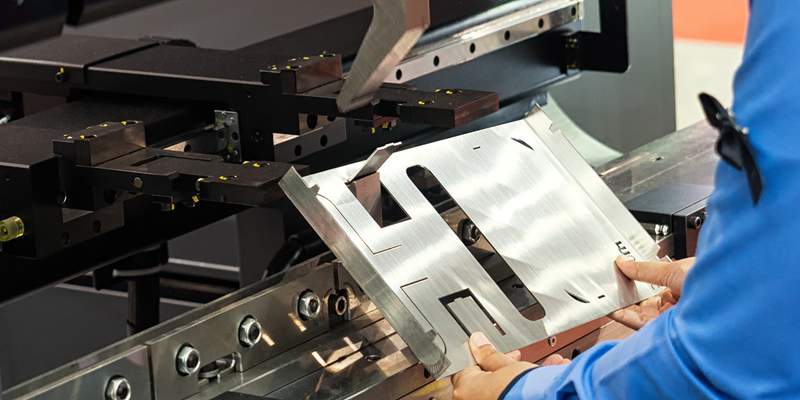- October 14, 2022
Sheet metal fabrication allows you to manufacture different products using a combination of various techniques and compatible materials. Consequently, the popularity of sheet metal manufacturing technology showcases its importance for a wide range of applications. However, it is crucial to understand how this process works, and you can take advantage of it.
This article examines the basics of sheet metal fabrication, describing the associated techniques and their applications. You will also learn the various advantages of the process as well as the suitable materials and surface finishes for the metal fabrication process. Read on to broaden your knowledge of the sheet metal process.
What is Sheet Metal Fabrication?
Sheet metal fabrication is a manufacturing technique that involves making products from flat metal sheets. As a result, you can fabricate sheet metal using different methods involving advanced machinery to form, bend, cut, and assemble metal into any preferred shape.
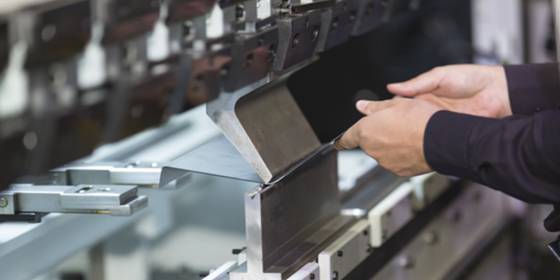
The various sheet metal fabrication process is compatible with many metal materials. These include stainless steel, aluminum, copper, brass, zinc, and steel. The thickness of these metal sheets ranges from 0.006 to 0.25 inches. Thinner gauges offer increased malleability, while thicker ones are perfect for heavy-duty applications.
In addition, sheet metal manufacturing works with the help of computer-aided design applications. It gives a 3D graphic representation of the end product of the production. The 3D files are usually transformed into machine code (G-code) which controls the operation. Thus, the machine can make precision cuts, joins, and forms final products from different metal sheets.
3 Types of Sheet Metal Fabrication Techniques
There are various techniques involved in custom sheet metal fabrication. Some of these techniques have more advantages and compatibility than others. Thus, gaining an in-depth knowledge of the different processes is essential to achieving the most efficient designs. The following provides a run-through of the 3 sheet metal fabrication techniques types.
- Cutting Sheet Metal
- Forming Sheet Metal
- Joining Sheet Metal
Sheet Metal Fabrication Cutting Techniques
Cutting is usually the first phase in the sheet metal fabrication process. You can cut different shapes or structures from rectangular metal sheets to meet design requirements. The main cutting techniques involved two categories: cutting without shear and with shear.
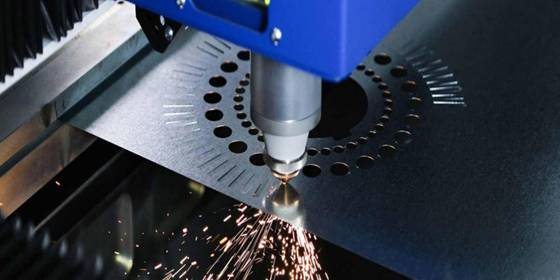
1. Cutting Without Shear
There are several processes that enable adequate cutting through sheet metal material without shear force. These techniques involve extreme heat, high pressure, vaporization, and abrasive blasting to shape the sheet metal fabrication parts. They include the following:
1.1 Laser Cutting
Sheet metal laser cutting involves using focused laser beams to melt metals in localized areas. Laser cutters are compatible with a long list of metals, ranging from non-ferrous metals to mild steel and stainless steel.
This technique consists of two concurrently running sub-processes. The first one involves concentrating a high-powered laser beam on the sheet metal. The material absorbs the laser beam’s thermal energy, making it vaporize.
At the same time, the second process involves a cutting nozzle providing blowing gas for laser cutting. This gas is usually oxygen or nitrogen. It helps to prevent the processing head from splashes and vapors during sheet metal fabricating engineering.
1.2 Plasma Cutting
Plasma cutting is a thermal cutting process involving metal with ionized gas called plasma. The method uses substantial heat to cut the metal, which creates large burrs and an oxidized zone close to the cut area. In addition, it allows faster cutting, high precision, and repeatability in sheet metal manufacturing.
The plasma cutting tool works effectively only on electrically conductive sheet metals. Consequently, it is one of the most suitable methods for cutting conductive materials with medium aluminum thickness.
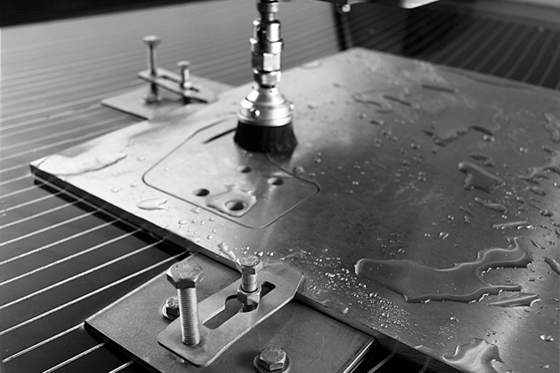
1.3 Waterjet Cutting
This cutting process involves using a high-pressure stream of water to cut metal sheets. Waterjet cutting is versatile and can cut various hard and soft materials using pressurized water and abrasive. It is ideal for cutting soft materials, metal foils, fabrics, or rubber. At the same time, it is suitable for cutting hard materials like copper, carbon steel, aluminum, and carbon steel.
The pressure involved is usually about 60,000 psi, with a 610m/s supply of velocity to cut through different types of metal sheets. However, waterjet cutting is a better substitute for the laser cutting technique.
2. Cutting With Shear
The processes under this category cut metal materials using shearing force to overcome the metal’s ultimate shear strength. They usually involve using dies, punches, and shear presses to enable adequate cutting of the metal. The techniques here include the following:
2. 1 Shearing
Shearing is suitable for high-scale applications and cutting soft materials that don’t need clean finishes, like brass, aluminum, and mild steel. It cuts straight lines on sheet metals with a flat surface. The shearing method involves applying a shear force on the surface, causing the flat metal material to split at the cutting point.
This is often the ideal process for making straight edges on a metal sheet with rough edges. It is cost-effective for high-volume operations when manufacturing thousands of sheet metal fabrication parts within a short lead time. However, shearing may not be perfect for applications that need quality finishes due to the burrs and material deformations it causes.
2.2 Punching
Punching uses shear force to make holes in the sheet metal. In this sheet metal fabrication process, the scrap material is the material removed from the hole, while the final component is the remaining material on the die.
Punching is suitable for making cutouts and holes of different shapes and sizes. However, using the punching process can take much time. You have to match the dies and punching knives correctly.
2.3 Blanking
Blanking is an ideal process for economic sheet metal fabrication. It involves removing a portion of sheet metal from a larger piece of the stock material using a blanking punch and die. The punch makes a “blanking force” through the sheet metal while the die holds it during the process.
The extracted material is the preferred component, while the remaining material on the die is the leftover black stock. This process is suitable for making economic custom parts due to its high repeatability, dimension control, and excellent accuracy.
2.4 Sawing
Sawing cuts metal materials using a sawtooth tool to create a series of tiny cuts in the metal. A sawtooth uses shear force and friction to tear apart a small part of the metal material. Band saws have various fine and marginally bent teeth suitable for cutting brass, aluminum, and other non-ferrous sheet metal.
Horizontal band saws help to cut longer bar stocks to desired sizes. On the other hand, vertical band saws help to achieve complex cuttings that need accurate contours in the metal parts.
Sheet Metal Fabrication Forming Techniques
The sheet metal forming techniques help reshape materials while maintaining their solid states. However, these techniques are different in their applications for creating custom sheet metal fabrication. This section will explain the essential forming techniques used in sheet metal engineering.
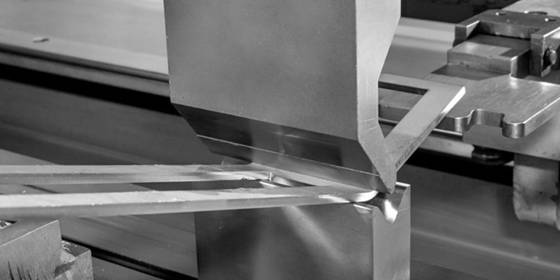
Bending
Sheet metal bending is highly cost-effective in low to medium-scale production. It involves deforming the metal’s surface with force and bending it at the required angle to create the preferred shape. You can use press brakes and a rolling machine to perform this operation. This technique is suitable for spring steel, copper, and aluminum 5052.
Rolling
Rolling involves passing a metal piece through a pair of rollers to gradually reduce the thickness of the metal or get a balanced thickness. These rollers constantly rotate with high efficiency to form compressive forces. Consequently, the forces plastically alter the shape of the workpiece.
Cold rolling and hot rolling are the two major rolling processes. Cold rolling often occurs at room temperature, while hot rolling occurs at a temperature beyond the material’s re-crystallization. Discs, stampings, wheels rims, tubes, and pipes, are typical rolled sheet metal fabrication parts.
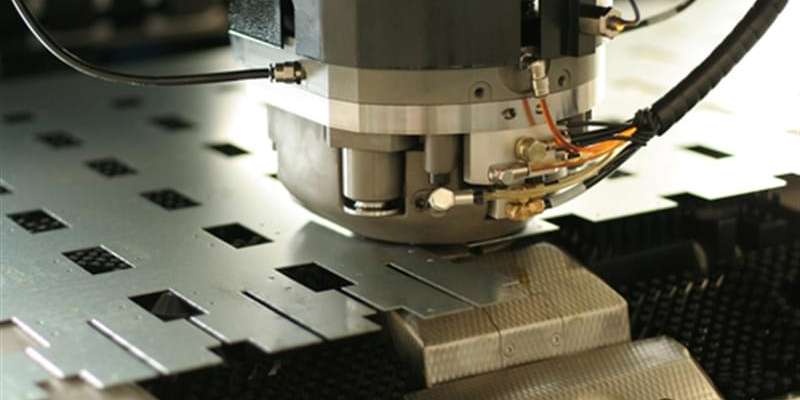
Stamping
Stamping combines complex cutting and forming processes with shorter sheet metal fabricating operations to achieve complex parts. Sheet metal stamping is a typical cold-forming technique that utilizes stamping presses and dies to shape raw materials into different shapes. It is compatible with many sheet metal materials – copper, aluminum, low- and high-carbon steel, and brass.
The metal stamping technique is often cost-effective, fast, and requires little tools and labor time. In addition, you can also automate the stamping process for high-quality precision parts and repeatability. However, it costs more to operate, and making changes to the design during production is challenging.
Hemming
Hemming is a custom sheet metal fabrication process that occurs when you roll over a sheet metal’s edge onto itself to form an area with two layers. It usually occurs in two different stages. Stage one includes blending the sheet metal and lowering it into a V-die. On the other hand, stage two involves the removal of the material and placing it into a flattening die. It helps to flatten the hem while giving it a preferred shape.
Hemming is often effective for strengthening parts’ edges and enhancing their appearance. The process has excellent accuracy that helps to create components with high-quality finishes. However, material deformation usually occurs during this process resulting in dimensional variations.
Curling
Curling is the process of joining round-like, hollow rolls to the edges of sheet metal. Its processes usually occur in three stages. The initial two stages form the curves for the curl, while the third one closes up the curl.
Curls effectively remove sharp untreated edges from a workpiece to make it safer for handling. Curling the edge gives it additional strength. However, curling can result in burrs and material deformation. As a result, the process needs the utmost care to get it right.
Sheet Metal Fabrication Joining Techniques
The following are joining techniques involved in the sheet metal fabrication process:
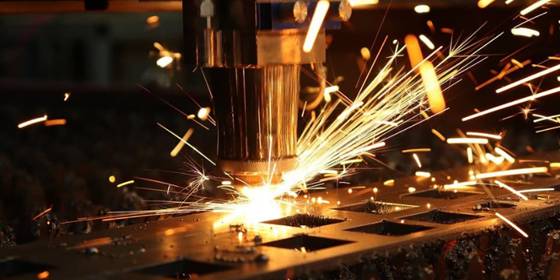
Welding
Welding is a standard process for joining sheet metal pieces into a single part by heating them to the melting point and using a torch to hold them. It is one of the fundamental processes in the final stages of sheet metal engineering. There are different sheet metal welding techniques, including:
- Shielded Metal Arc Welding (SMAW)
- Metal Inert Gas (MIG) Welding
- Tungsten Inert Gas (TIG) Welding
These three techniques have different approaches. However, they all have the purpose of joining metals by melting the edge of the parts and putting fillers. As a result, they form a metallurgical bond between the pieces to join them firmly.
Riveting
Riveting involves drilling a hole in the pieces of metal sheets to be joined and then installing the rivet. After inserting the rivet, you deform the rivet’s tail by squashing it. Doing this flattens the rivet’s tail, preventing it from falling off. Moreover, riveting is suitable for non-ferrous metal parts like aluminum and copper.
It occurs in two forms – cold riveting and hot riveting. Cold riveting is ideal for non-ferrous and lightweight metals with diameters below 10mm. In contrast, hot riveting involves applying heat of 1000 – 1100ᵒC to steel rivets above 10mm.
Advantages of Sheet Metal Manufacturing
Sheet metal fabrication comprises various techniques to help create components for many industries. The major advantages of sheet metal fabrication include the following:
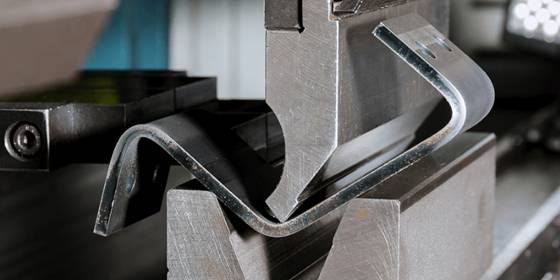
Lightweight Parts Manufacturing
Sheet metal manufacturing is ideal for producing lightweight components. Industries that require lightweight engine parts, such as aerospace and automotive, depend on custom sheet metal fabrication for superior-quality materials and techniques.
Besides, this manufacturing method helps to create sheet metal fabrication parts that improve aircraft and automobile fuel economy while assuring efficiency.
Extensive Techniques and Materials
As discussed in this article, various techniques are associated with the sheet metal fabrication process. Therefore, there is no shortage of techniques to choose from for your project.
This manufacturing process also allows you to select from a wide array of sheet metal materials, including copper, stainless steel, steel, aluminum, and other custom sheet metals. The material you choose will determine the application of your end product.
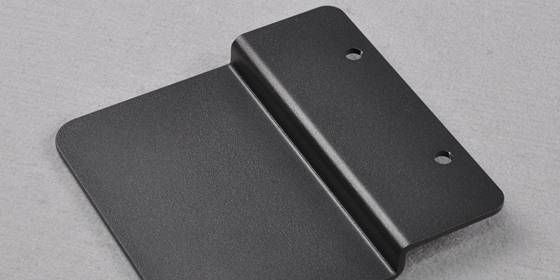
Efficiency and Accuracy
The sheet metal technology offers increased efficiency and accurate fabrication capabilities. It helps to create prototypes faster with high precision and accuracy. For example, some laser cutters achieve cuts with about 0.0005 inches.
Moreover, it is essential to understand that most sheet metal techniques are automated. So, the machines start operating once you enter the codes on the computer. The process prevents human errors. Therefore, the final products usually have very little or no deformations.
Available Sheet Metal Fabrication Materials
There is a long list of materials compatible with sheet metal engineering. Here are some common of the sheet metal fabrication materials:
- Stainless steel
- Hot rolled steel
- Cold rolled steel
- Pre-plated steel
- Carbon steel
- Aluminum
- Copper
- Brass
Surface Finishes for Sheet Metal Fabrication
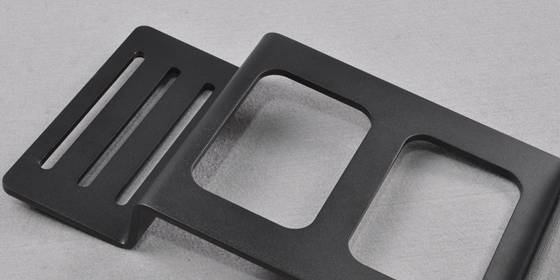
Surface finishing is a fundamental aspect of custom sheet metal fabrication. It gives fabricated parts both functional and aesthetic advantages. These are some of the surface finishes for sheet metal fabricated parts:
- Powder coating
- Bead blasting
- Brushing
- Electroplating
- Anodizing
- Laser engraving
- Screen printing
Industrial Applications of Sheet Metal Fabrication Parts
Several industries use sheet metal fabricated parts in their daily operations. Here are some of these industries:
Automotive
The sheet metal fabrication process paved the way for the innovative design of automobiles due to the availability of production-grade materials. The metal-forming capabilities of this technology help create perfect frames from thin metal sheets.
Hence, most car parts undergo punching and laser operations. For example, most vehicles’ hoods, fenders, side panels, and roofs are sheet metal engineering products.
Aerospace
Custom sheet metal fabrication facilitates the production of several space-worthy components and lightweight parts. Components used in the aerospace industry usually require tighter tolerances and high precision. Therefore, you can combine metal sheets like aluminum and steel with improved methods to create complex spacecraft and aircraft designs.
Healthcare
Sheet metal engineering helps to detect design errors and proffer reliable solutions due to medical tools’ quality and accuracy demands. Sheet metal prototyping and manufacturing are ideal for MRI applications and for producing scalpels and surgical instruments. You can automate these processes to prevent human error and improve accuracy in fabricating medical devices.
Enclosures
Sheet metal fabrication helps produce economic housing enclosures to safeguard sensitive gearboxes and equipment. In addition, fabricated parts protect tools from the environment, preventing dust from getting in. Likewise, using sheet metal fabricating techniques, you can make various cutouts for cable connections, such as glass windows, LED panels, light pipes, and HDMI.
Design Tips for Sheet Metal Fabricating
Here are some vital sheet metal design tips for manufacturability:
Wall Thickness
Each component’s geometry must maintain a uniform thickness because sheet metal fabrication parts are manufactured from a single metal sheet. Generally, you can manufacture sheet metal parts with at least 0.9 mm to 20 mm thickness.
However, different custom sheet metal fabrication techniques are compatible with varying thicknesses. For an instant, laser cutting is suitable for metal with thicknesses between 0.5 mm to 10 mm. In contrast, sheet metal bending can work with metal sheets between 0.5 mm to 6 mm thickness.
Holes and Slot Orientation
Holes and slot diameters are essential factors to consider when modeling parts in custom sheet metal fabrication. The diameter of the holes and slots should be as large as the thickness of the material. In addition, you should give enough space between the holes. You should never put the holes too close to the edge of the material.
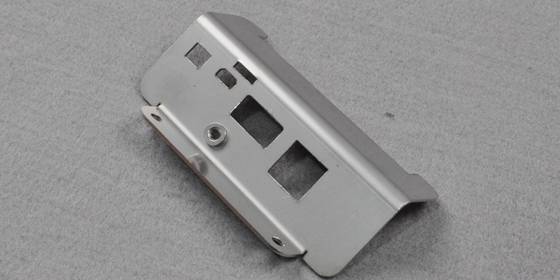
Bend Allowance and Deduction
Bend allowance is the additional material length you need to add to the actual measurement of the parts to create a flat pattern. On the other hand, bend deduction is the material that needs to be cut out from the length of the flanges to gain a balanced design.
Bend Radii
Keeping the internal bend radius of sheet metal at an equal measurement to its thickness is very important. It prevents sheet metal defects and distortions in the final products. As a result, maintaining consistent bend radii across the part helps to ensure excellent orientation and cost-effectiveness in sheet metal engineering.
WayKen's Sheet Metal Fabrication Services
Partnering with the best manufacturers that provide superior sheet metal fabrication services is crucial. WayKen provides high-quality sheet metal manufacturing services with the best experience. Combined with advanced technologies and skilled technicians, we can always meet your various machining needs with high standards.
In addition, as an ISO-certified company, we ensure you get the best prototypes and final products for sheet metal fabrication parts. At WayKen, we provide 100% part inspection support to help you get the best from your project. Contact us today to get an instant quote and DFM feedback.
Conclusion
Manufacturing parts with sheet metal fabrication is an excellent option. It offers various benefits, ranging from efficiency and accuracy to fabricating lightweight components and compatibility with multiple materials and techniques. So, understanding the different methods, applications, and design tips involved in this process is essential for the success of your project.
FAQ
How does the sheet metal fabrication process work?
The sheet metal fabrication process manipulates or alters sheet metal materials into different geometries by cutting, forming, or joining them. The process starts with concept generation and the creation of engineering drawings.
Then, engineers use various processes to develop prototypes according to the design model. After prototype development, product testing, and design changes, full-scale production of intended products can then begin.
What are the main sheet metal fabrication techniques?
The major techniques in sheet metal fabrication are generally classified under three categories. These include cutting, forming, and joining. Each category has the various number of unique processes that are useful for several applications.
What is the maximum thickness for sheet metal fabrication?
The thickness of sheet metal usually ranges between 0.5 mm and 6 mm. The thinness of the metal sheets makes them very easy to fabricate while providing adequate strength for intended purposes.

